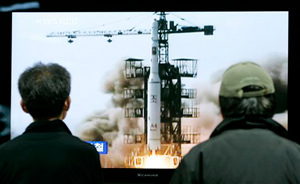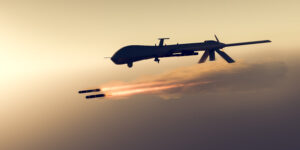Up, Up and Away: The West’s Hysterical Reaction to North Korea
North Korea has come under strong international criticism and sanctions for its missile launch, but as a signatory to the 1966 Outer Space Treaty, it is legally permitted to pursue space launch activity. Besides, where is the pandemonium when Japan, Pakistan, Israel, India, Russia and the U.S. refine, test and launch their own ballistic missiles?
Six minutes before 1 o’clock in the afternoon, on Jan. 23, a 173-foot-tall, two-stage rocket lifted off from Northeast Asia. Capable of carrying a giant 33,000-pound payload, the rocket’s liquid-fuel engine, supplemented by two solid-fuel strap-on booster rockets, generated nearly half a million pounds of thrust before giving way to the second stage, likewise powered by a liquid-fuel engine. After reaching a height of nearly 430 miles, the rocket released into orbit a 3,850-pound satellite, along with seven smaller probes. Other than the small community of scientists interested in the data expected to be collected from the “Ibuki” Greenhouse Gases Observatory Satellite (GOSAT), the rocket’s main payload, very few people around the world took notice of the launch. The United Nations Security Council did not meet in an emergency session to denounce the launch, nor did it craft a package of punitive economic sanctions in response.
The reason? The rocket in question, the H-2A, was launched by Japan, at its Tanegashima Space Launch Facility. Deemed an exclusively civilian program, the H-2A has been launched 15 times since its inaugural mission on Aug. 29, 2001. Four of these launches have been in support of exclusively military missions, delivering spy satellites into orbit over North Korea. Although capable of delivering a modern nuclear warhead to intercontinental ranges, the H-2A is seen as a “non-threatening” system since its liquid-fueled engines require a lengthy fueling process prior to launching, precluding any quick-launch capability deemed essential for a military application.
In contrast, on April 5, at 11:30 in the morning, North Korea launched a three-stage rocket called “Unha,” or “Milky Way,” which it claimed was carrying a single small communications satellite weighing a few hundred pounds. Like the H-2A, the “Unha,” better known in the West as the Taepodong-2, is liquid-fueled, requiring weeks of preliminary preparation before launch. Although North Korea declared the vehicle to be intended for launching a satellite, the launch was condemned even before it occurred as “dangerous” and “provocative,” unlike Japan’s similar efforts.
The Taepodong-2 launch was the second attempt by the North Koreans to get this particular design airborne. In 2006, the first effort ended in failure when the rocket exploded some 40 seconds after liftoff. The second launch, by all accounts (except North Korea’s, which announced that its satellite was successfully orbiting the Earth, broadcasting patriotic music), was likewise a failure. The first stage, based on a Chinese design derived from the CSS-2 missile, seemed to function as intended, given the fact that it splashed down in the Sea of Japan in the area expected. However, the second stage, together with the smaller solid-fuel third stage designed to boost the satellite into orbit, fell several hundred miles short of its anticipated impact area, indicating a failure of the second stage to perform properly and, ultimately, launch the satellite. Western hysteria, which labeled the North Korean rocket a direct threat to the western United States, prompting calls for the missile to be shot down, proved unfounded.
In October 2006, in response to North Korea’s announcement that it had conducted an underground test of a nuclear weapon, the Security Council of the United Nations passed Resolution 1718. This resolution, passed under Chapter VII of the U.N. Charter, condemned the North Korean nuclear weapon test and called for the imposition of economic sanctions until North Korea’s nuclear weapons program was dismantled and its nuclear program as a whole reintegrated into the nuclear nonproliferation treaty. It also singled out North Korea’s ballistic missile programs, demanding that Pyongyang “not conduct any further … launch of a ballistic missile” and “suspend all activities related to its ballistic missile program and in this context re-establish its pre-existing commitments to a moratorium on missile launching” and “abandon all other existing weapons of mass destruction and ballistic missile programme in a complete, verifiable and irreversible manner.”
The April 5 launch was widely condemned by the United States and others (including Japan, which assumed a leading role in framing the North Korean test as “destabilizing” and “dangerous”). President Barack Obama characterized the North Korean launch as a violation of Security Council resolutions and pushed for the council to punish Pyongyang. However, not everyone shared the sentiments of the United States and Japan. Both Russia and China questioned whether the launch was in fact a violation of Resolution 1718, noting that North Korea had every right to launch satellites. The best the United States and Japan could get from the U.N. Security Council was a statement issued by the council president condemning the launch as a “contravention” of Security Council Resolution 1718 and demanding that North Korea “comply fully” with its obligations under the resolution. The statement also demanded that North Korea not shoot off any more rockets or missiles. Thus it appears that the United Nations Security Council, and not North Korea, is acting in a manner inconsistent with international law. On March 5, 2009, North Korea notified Russia that it was joining the 1966 Outer Space Treaty. Russia is one of three depository states for that treaty (the other two being the United States and the United Kingdom), and North Korea’s announcement made the commitment binding. At the same time, North Korea informed the U.N. secretary-general that it was joining the 1974 Convention on Registration of Objects Launched Into Outer Space. The Outer Space Treaty proclaims “the exploration and use of outer space shall be carried out for the benefit and in the interests of all countries and shall be the province of all mankind,” and that “outer space shall be free for exploration and use by all States.” North Korea’s joining the 1974 convention, while not mandatory, put it in compliance with the established practices of other nations having space launch programs, including Iran, which signed the treaty back in 1967, and which on Feb. 2, 2008, successfully launched a satellite on board its two-stage Safir-2 (“Ambassador”) vehicle. While the United States and others strongly criticized the Iranian action, Russia noted that Iran had not violated international law. The same holds true of the North Korean launch.
A major problem confronting President Obama and others who fear that North Korean and Iranian launches are merely a cover for the development of technologies useful for military ballistic missile programs is that, unlike in the nuclear field, where the nuclear nonproliferation treaty (NPT) seeks to control nuclear weapon technologies and activities within a framework of binding international law, there is no corresponding treaty vehicle concerning ballistic missiles. In 1991, the U.N. Security Council did impose restrictions on ballistic missile technology for Iraq in the aftermath of the Gulf War, but this was a case-specific action which, in defining its mandate, had to turn not to an existing body of binding international law-based definitions, but rather to a voluntary arrangement known as the Missile Technology Control Regime [MTCR], brought into being in 1987. Today the MTCR consists of 34 members, all of which have agreed to abide by a regime that controls the availability of missile-related technology to nonmember states. But the MTCR does not carry with it the force of law, and has become politicized over the years through the inconsistent application of its mandate to the point that it is viewed by many nonsignatory nations as sustaining the military advantage of the member nations.
While both North Korea and Iran have come under strong international criticism and sanctions for their respective nuclear and missile activities, it should be noted that neither nation has acted in a manner which violates international law. North Korea withdrew from the NPT prior to testing its nuclear weapon, and Iran’s nuclear enrichment program operates with full transparency and in keeping with its obligations under the NPT. As signatories to the 1966 Outer Space Treaty, both nations are legally permitted to pursue space launch activity, and the MTCR does not ban ballistic missile development, but rather merely prevents signatory nations from providing such technology to nonsignatory nations. But the lack of international outrage and demands for sanctions against nations such as Israel, Pakistan and India (all of which possess nuclear weapons programs operating outside the NPT, as well as military ballistic missile programs designed to deliver these nuclear weapons) undermines the legitimacy of the current attention on North Korea and Iran.
On the day North Korea launched its “Unha” vehicle, President Obama delivered a speech in Prague, the Czech Republic, which was hastily redrafted to take the North Korean action into account. “North Korea broke the rules,” Obama said. “Rules must be binding. Violations must be punished. Words must mean something.” These bold statements were made at the same time the president was calling for a global abolition of nuclear weapons and a strengthened NPT as “a basis for cooperation,” one which would require “more resources and authority to strengthen international inspections” and deliver “real and immediate consequences for countries caught breaking the rules or trying to leave the treaty without cause.” The president outlined a valid (if vague) course of action concerning nuclear weapons, but having linked nuclear weapons with ballistic missile delivery vehicles, he remained conspicuously mute on how he envisioned containing and controlling that threat.
Expansion of the MTCR is not a viable option, although in its most recent plenary session the MTCR underscored the importance of the regime working closely with the United Nations to follow through on measures put in place under Security Council Resolution 1540, passed in 2004 under Chapter VII of the U.N. Charter. Those measures require all states to “establish domestic controls to prevent the proliferation of such weapons and means of delivery, in particular for terrorist purposes, including by establishing appropriate controls over related materials, and adopt legislative measures in that respect.” The resolution specifically said that none of its obligations should be interpreted “so as to conflict with or alter the rights and obligations of State parties to the Nuclear Non-Proliferation Treaty, the Chemical Weapons Convention and the Biological and Toxin Weapons Convention or alter the responsibilities of the International Atomic Energy Agency (IAEA) or the Organization for the Prohibition of Chemical Weapons (OPCW).” This reflects the reality that there is established, binding international agreement on nuclear, chemical and biological weapons. There is no such agreement on ballistic missiles. This is the missing link in Obama’s call for a nuclear-free world. It will be difficult enough to convince entrenched domestic special interests, both economic and political, that we would be safer without nuclear weapons. It will be impossible to sell such a program internationally unless it is coupled with a similar undertaking involving the very missiles and related technology the MTCR seeks to restrict. Such a restriction cannot be limited to those nations which do not currently possess such technology, but rather must be binding on all nations. While the world was focused on the launch of the North Korean missile, almost unmentioned was the testing of an SS-25 intercontinental missile by Russia on April 10. This missile, designed and equipped to deliver a single 500-kiloton nuclear warhead, flew 6,000 miles before hitting its designated target area (the warhead used was a dummy). And what about February’s test launch of a U.S. Navy D-5 ballistic missile from a Trident submarine? This missile flew some 4,000 miles and was equipped with multiple warheads. There was hardly any mention of the test of a U.S. Minuteman III missile in July 2006, made six days after the U.S. orchestrated Security Council condemnation of North Korea’s failed launch of a Taepodong-2 space launch vehicle. India, Pakistan and Israel have all conducted recent tests of their respective nuclear-capable ballistic missile arsenals. If the world is going to be serious about getting rid of nuclear weapons, then it must also address the issue of eliminating those delivery vehicles which provide the most viable vector for nuclear attack — ballistic missiles.
Combining the goals and intent of the MTCR with the 1966 Outer Space Treaty would be a good place to start. Banning ballistic missiles yet maintaining space launch capability are not mutually exclusive objectives. The technologies might be similar, but the employment methodologies are not. Military ballistic missiles are deployed in secrecy and rapidly prepared for launch. Space launch vehicles are operated in full transparency, on declared schedules with announced objectives. If the list of technologies currently controlled by the MTCR was expanded to include all technologies associated with missile launch activity, and access to such technologies made conditional on their use in declared, carefully monitored space launchings controlled by a binding international treaty, it would be possible to rid the world of the scourge of global nuclear attack by not only removing the nuclear weapons but also the most effective means of their delivery. Obama and others who criticize North Korea and Iran would do well to reflect on such a possibility the next time they embark on the ineffective and hypocritical path of assailing those who simply seek to acquire what we already have — whether it be nuclear weapons, nuclear technology, ballistic missiles or space launch capability.
|
Scott Ritter was a U.N. weapons inspector in Iraq from 1991 to 1998 and a U.S. Marine intelligence officer. He is author of “Target Iran” (Nation Books, 2006) and the forthcoming “On Dangerous Ground: Following the Path of America’s Failed Arms Control Policy,” also published by Nation Books. |
Independent journalism is under threat and overshadowed by heavily funded mainstream media.
You can help level the playing field. Become a member.
Your tax-deductible contribution keeps us digging beneath the headlines to give you thought-provoking, investigative reporting and analysis that unearths what's really happening- without compromise.
Give today to support our courageous, independent journalists.







You need to be a supporter to comment.
There are currently no responses to this article.
Be the first to respond.